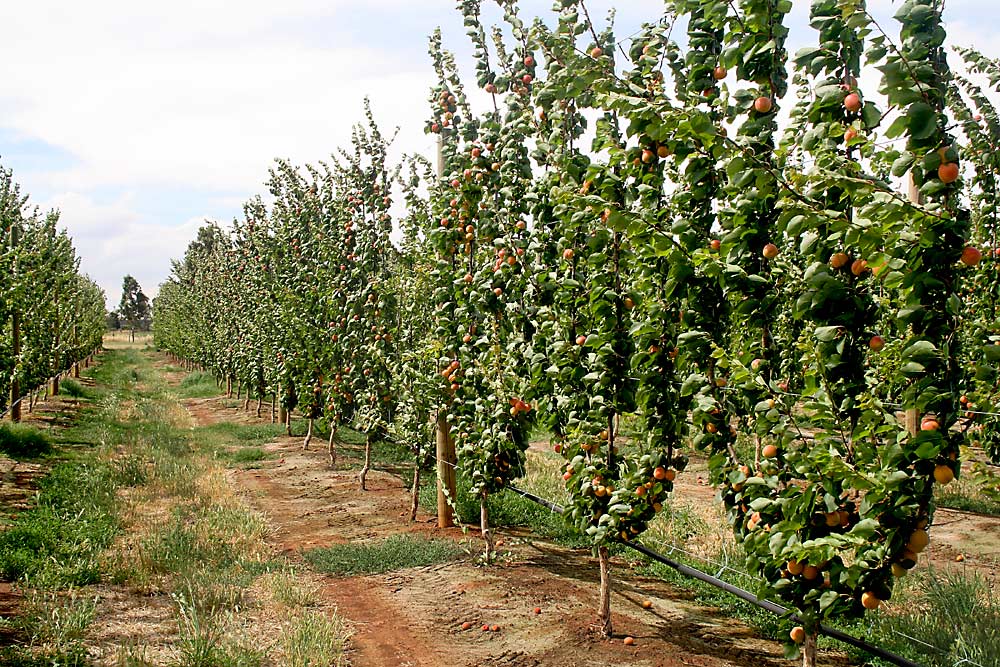
Specifications of orchard systems to meet the needs of the stone fruit industry will continue to be influenced by a combination of cultural, economic and marketing conditions.
Multileader two-dimensional (2D) fruiting walls are becoming popular with Australian orchardists who want intensive production systems, especially when a vigorous rootstock can be used at a moderate tree density and trees have a simple structure that is efficient and labor friendly.
Intensive apricot production has lagged behind that of apple, presumably because apricot trees are grown on vigorous plum rootstock. However, training apricot trees with multiple leaders that have no branches, only fruiting units, may offer orchardists quicker returns on investment through earlier bearing and more efficient labor use, move quickly into production with new varieties and improve competitiveness.
The advantage of using a vigorous rootstock is that the trees have the strength to quickly fill their allotted spaces, with the support of an upright trellis.
The resulting 2D trees are easy to pick, prune, thin and spray.
This article deals with the development of the tree’s structure and setting up the trees for a long, productive life.
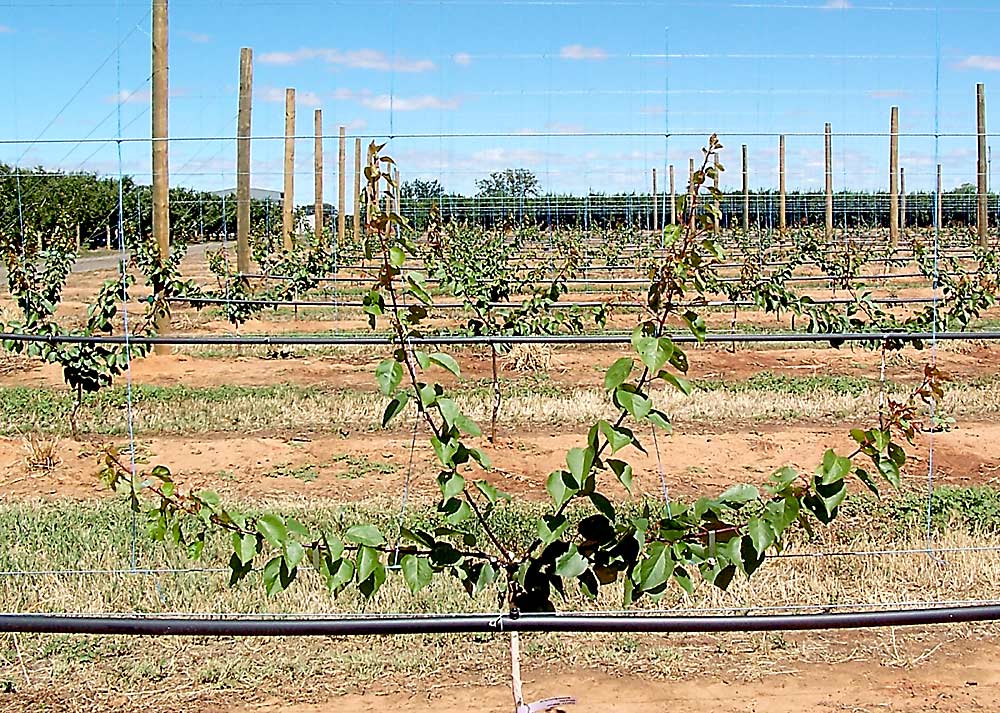
Design of the production system
Rows are 4 meters (13 feet) wide, and trees are planted 2 meters (6.5 feet) apart, giving a moderate density of 1,250 trees per hectare (approximately 506 trees per acre). The rootstock is Myrobalan, a highly vigorous plum seedling.
The multileader 2D design follows a simple hierarchic growth pattern.
Each tree has four leaders spaced 0.50 meter apart. The leaders, together with the short trunk, form the permanent structure of the tree.
Leaders are dressed with fruiting units only; branches are not allowed to develop. Fruiting units are short (100- to 300-mm, or 4- to 12-inch) pieces of 1-, 2- and 3-year-old wood with leaves, floral and vegetative buds. They can be shortened and renewed in autumn to ensure they remain strong and reproductive. The fruiting units form the bearing wood of the leaders.
The thin (600-mm, or 2-foot) upright wall depth allows all the producing parts to have good access to sunlight. The spread of the trees is provided by the fruiting units arranged two-dimensionally.
Benefits of a strong rootstock
Vigor of the Myrobalan rootstock ensures quick development of the tree’s permanent structure. Vigor is divided equally over these four leaders.
With 5,000 leaders per hectare (approximately 2,020 leaders per acre) and a simple tree structure, it is easy to set up the trees for target yields with the right fruit numbers.
Canopy building
Specific early tree training is critical to get a well-balanced fruiting canopy established quickly. Advantages are soon lost if management and tree training are not carried out correctly.
Selecting, positioning and developing four uniform leaders is of utmost importance for successful orchard management and high tree performance.
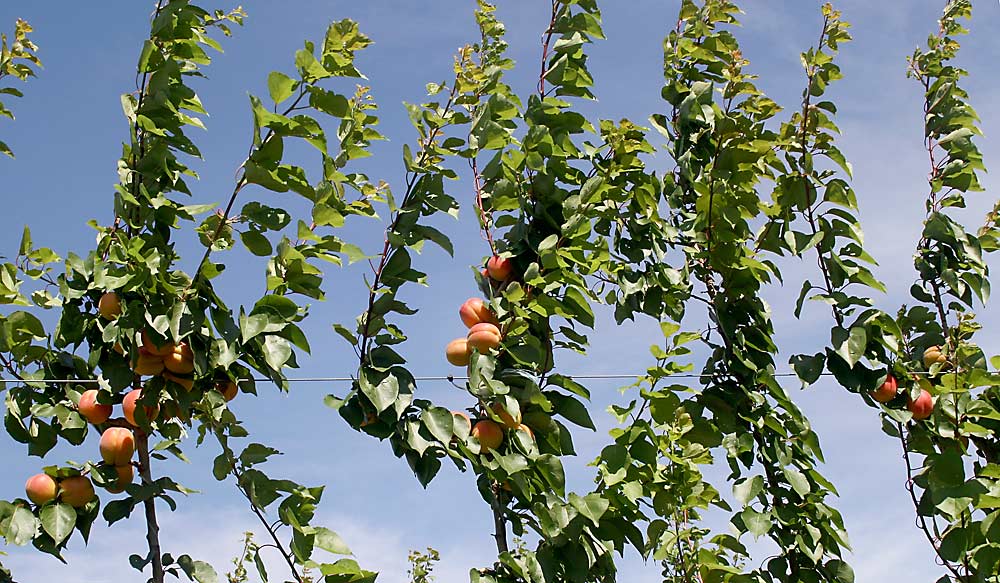
In spring, select four leader-shoots from each headed nursery tree. Avoid selecting the first two or three shoots immediately under the cut, because these are often upright and vigorous. Shoots lower down often have wider angles and are more uniform.
To position the leader-shoots, train each one with the help of a string tied every 500 mm (approximately 20 inches) from the bottom to the top wire. Regularly fasten the young growing leader-shoot to the string with a tapener plant-tying tool. Use 100 mm (4-inch) plastic ties to secure the leader-shoot to each 2.65 mm (0.10-inch) high-tensile galvanized wire. Weave each leader-shoot between the four or five wires as it grows up along the string.
To develop four uniform leader-shoots, distinction must be made between the two inner and the two outer ones. The two inner leader-shoots tend to have much more vigor than the two outer ones, because they are closest to the trunk and above the roots. For this reason, you must first create strong growth in the outer leader-shoots and subdue (by pinching) growth of the inner ones.
Stub-cut any flushes of sylleptic shoots. These are shoots that appear on current growth.
Do all this initial pruning and training in spring and summer to ensure that most energy goes into growth of the leader-shoots and the trees remain free of bacterial canker.
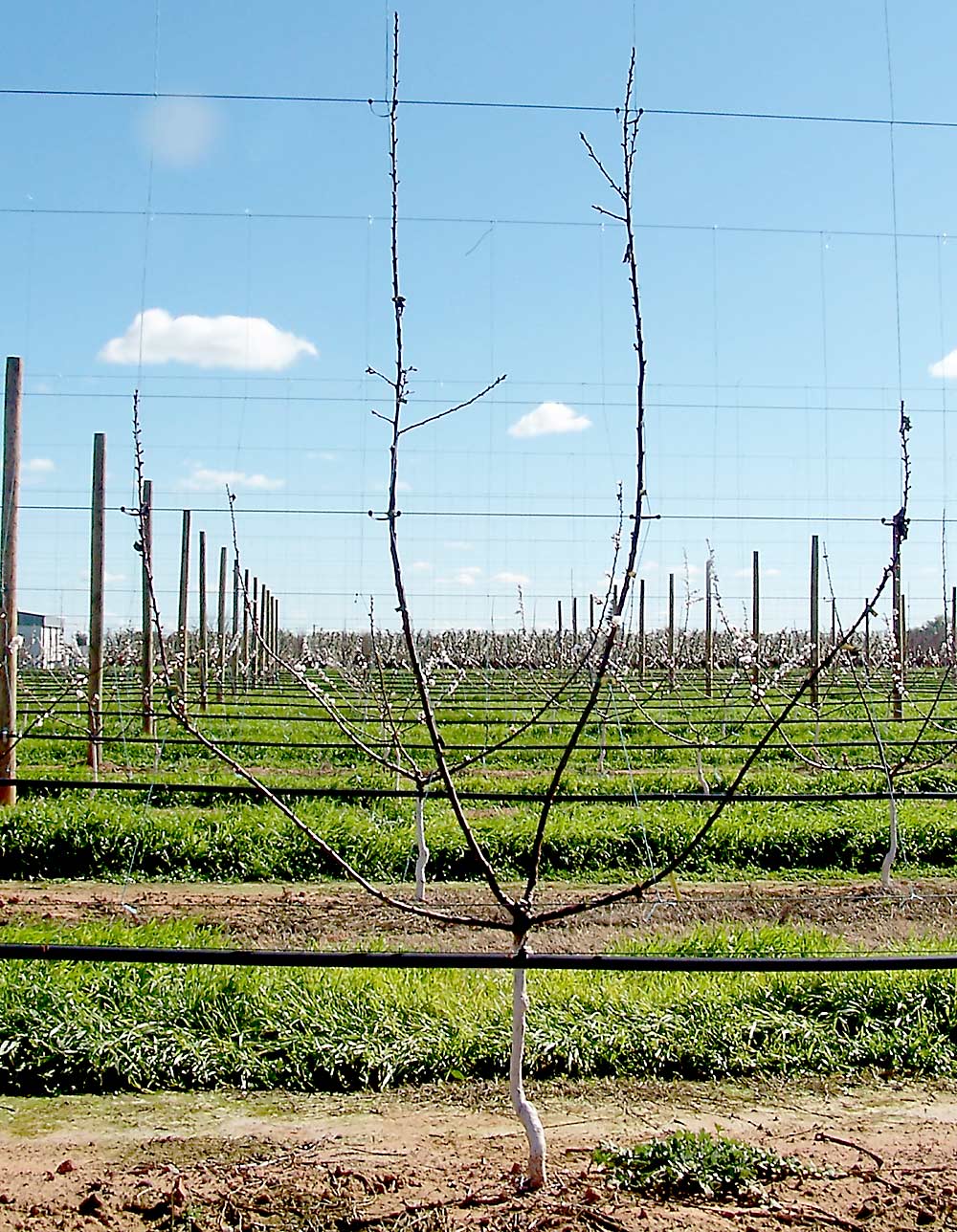
The fruiting units are allowed to develop from the base of each leader. These start as short laterals and spurs. A spur is a contracted lateral. Spurs must maintain a terminal vegetative bud that can make leaves and extend the spur the next season.
Full canopies are made up of numerous low-vigor fruiting units and spurs that allow transient dappled light to penetrate through the canopy, providing a good environment for renewing the bearing wood and optimum production of fruit with good size, color and taste.
Bearing wood management
An understanding of the fruiting habit is essential to maintain good quality bearing wood. Buds at the basal end of a fruiting unit typically become flower buds. Apricots do not have mixed buds. After flowering or fruiting, no vegetative buds are left to form leaves and shoots to create new fruiting positions, and the fruiting unit quickly becomes bare. This is called natural floral bud extinction, and to minimize this problem, you need to do four things:
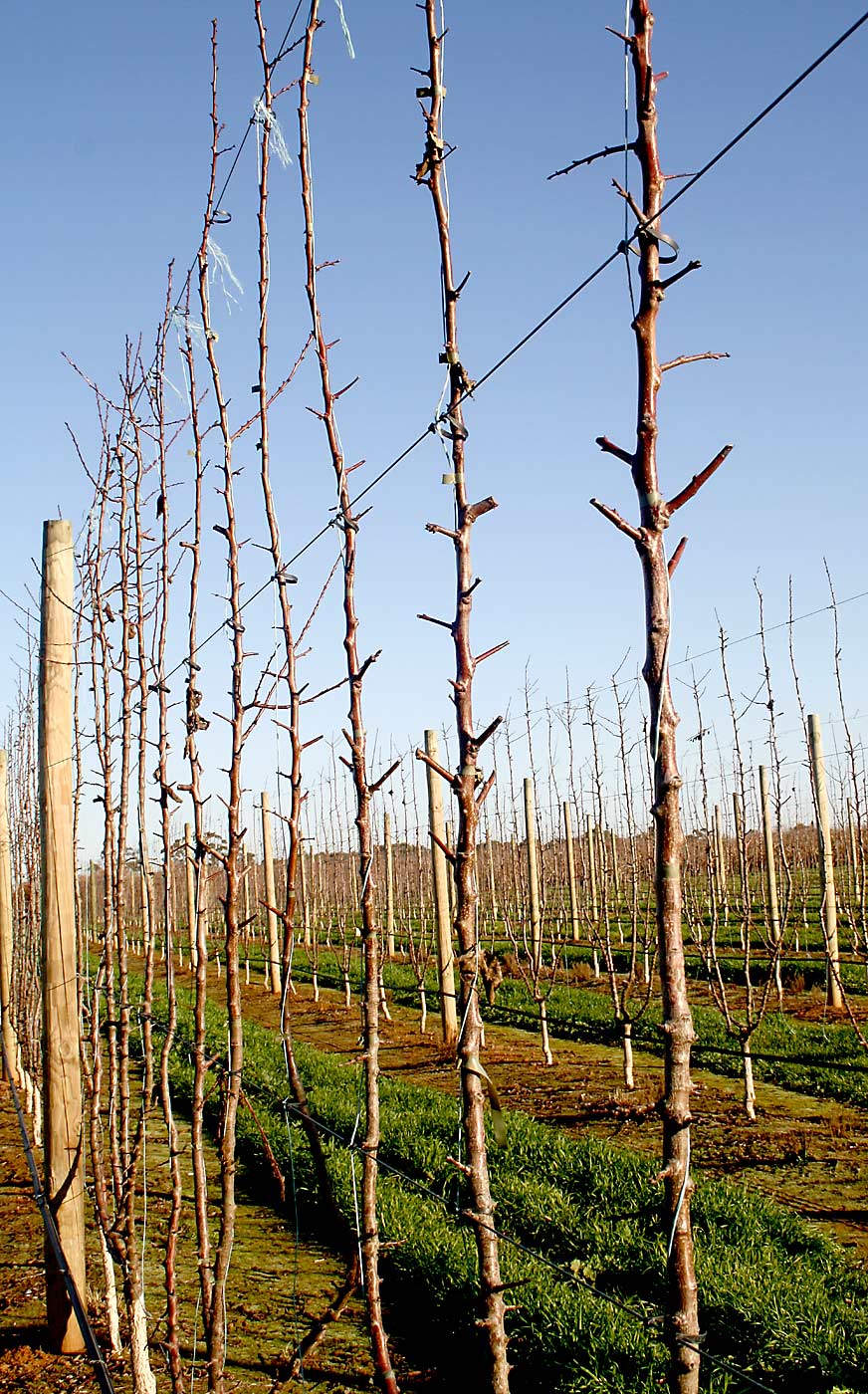
1) Maintain a hierarchic growth habit, where the extension growth of the leader is initially kept dominant. When the canopy is fully developed, the tops are pruned soon after harvest at the maximum permissible height (80 percent of row width).
2) During summer, encourage growth of new semi-weak laterals. These will form the next new fruiting units. You also need to stub-cut strong shoots with wide angles to encourage soft regrowth. Remove any strong upright shoots; these will never become good fruiting units.
3) Fertigate twice a month and keep chewing insects away, especially from the growing leader tips. Leaders can grow more than 25 mm (1 inch) a night.
4) In autumn, a rigorous renewal of bearing wood is necessary by cutting back into the fruiting wood to stimulate vegetative growth the following season. New growth will form from the rudimentary buds on the piece that is left and also on the nearby leader.
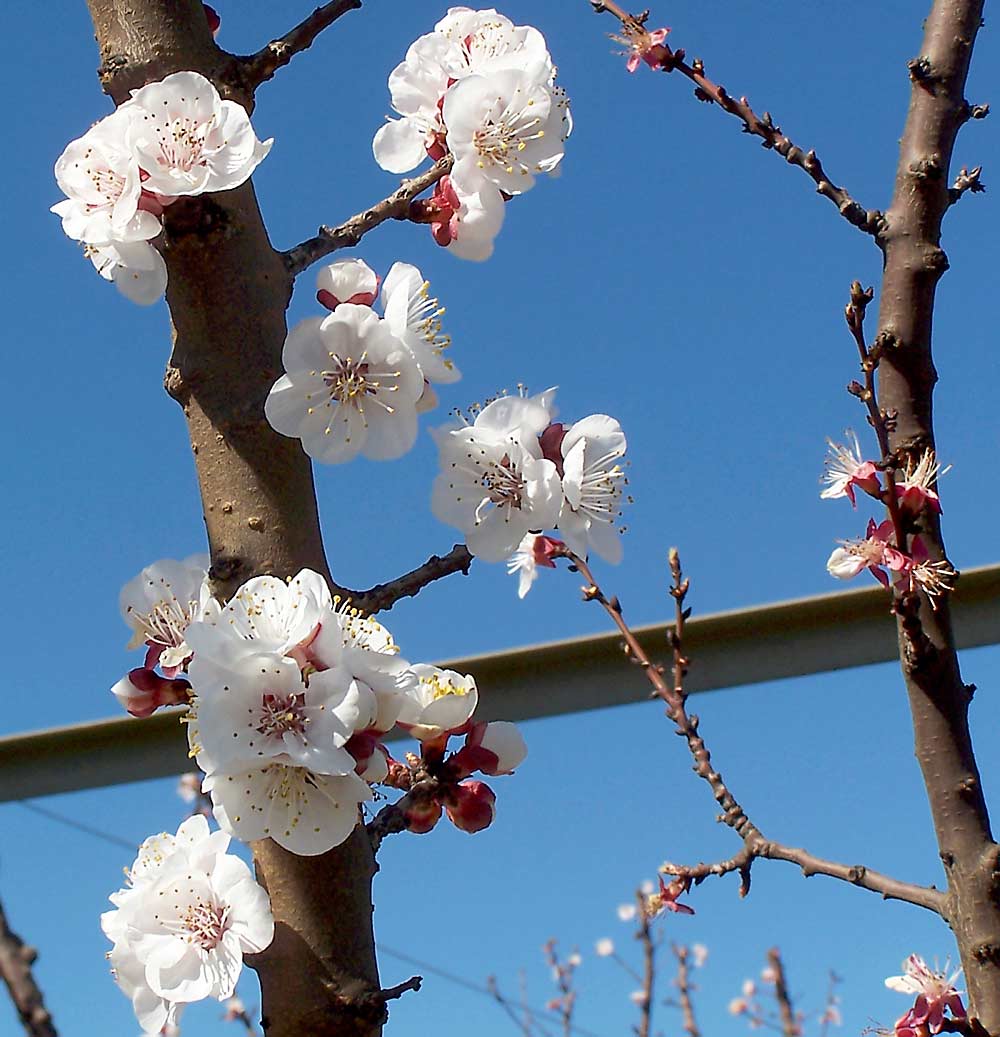
When the tree canopy is fully developed, usually within three years, impose a postharvest water-stress strategy. In Australia, regulated deficit irrigation is used after harvest during the long hot summers to control vegetative growth and keep the leaders calm.
As well, with good management of sunlight, fruiting units last longer and ensure regular production and consistent fruit quality via controlled vigor in the bearing wood.
Creating fruiting units
During the first three years, the trees not only developed their permanent structure of twin branchless leaders, they also produced two crops. The fruit were borne on short spurs on the leader, because development of fruiting units was delayed to promote extension growth of the leaders.
After the third year, the leaders had reached their maximum permissible height of 3.20 m, or 10.5 feet, which is 80 percent of row width (4 m, or 13 feet).
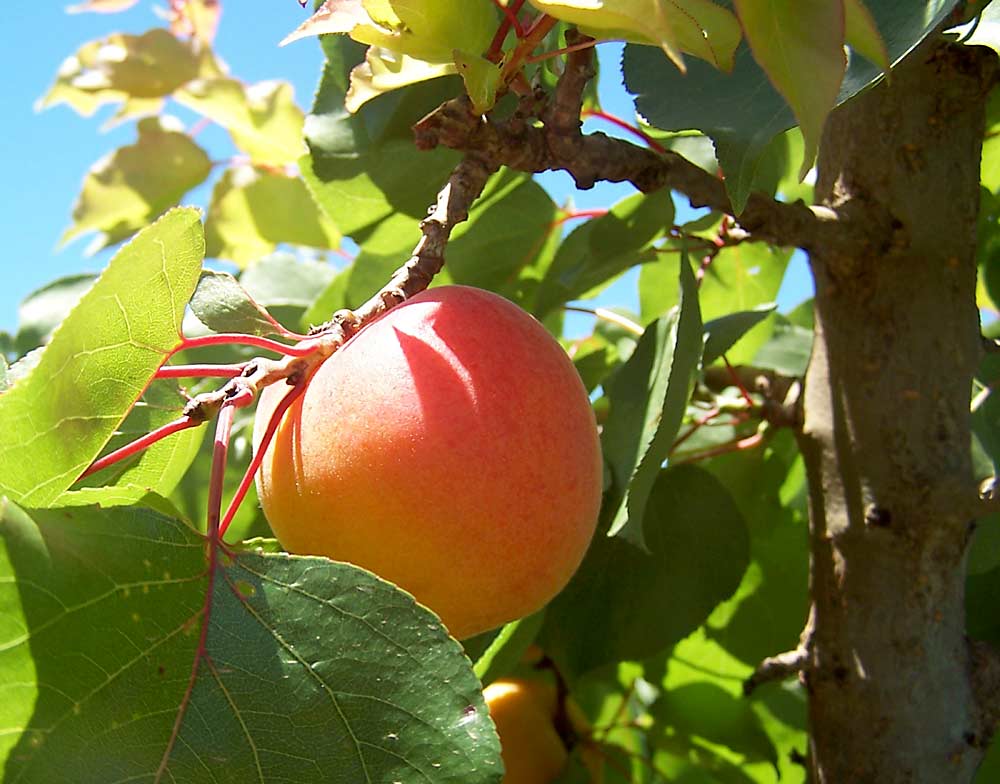
To optimize a sustainable production, a combination of young spurs and fruiting units is required. Fruiting units are short (100- to 300-mm, or 4- to 12-inch) pieces of 1-, 2- and 3-year-old wood created and renewed during the summer months. Apricot trees are not pruned in winter because of the risk of bacterial canker infections.
—by Bas Van Den Ende
"fruit" - Google News
June 29, 2021 at 09:20PM
https://ift.tt/3AcgVWr
Good to Know: Approaching apricots in 2D - Good Fruit Grower
"fruit" - Google News
https://ift.tt/2pWUrc9
https://ift.tt/3aVawBg
Bagikan Berita Ini















0 Response to "Good to Know: Approaching apricots in 2D - Good Fruit Grower"
Post a Comment